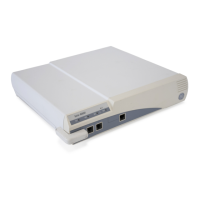2026265-075C Solar 8000M/i patient monitor 3-11
Installation: TRAM-NET communication
TRAM-NET communication
Overview
The Solar patient monitor uses two distinct local area networks:
TRAM-NET communication, and
Ethernet communication.
Consider TRAM-NET as a small area network (SAN) contained in one
room or at the patient bedside. Consider Ethernet as the local area
network (LAN) for room-to-room communication or communication
between patient monitors, central stations, and other GE equipment
throughout the hospital.
NOTE
GE highly recommends using a ‘private’ LAN to connect Unity
products. The purpose of the Unity Network is to connect only Unity
devices for the exchange of patient data and room-to-room
communication. Adding non-Unity devices (PCs, laptops, desktops,
etc.) may compromise the ability of the Unity Network to meet its
intended use.
A ‘private’ LAN is not the same as a private IP address.
This local area network links all patient monitors, central stations, and
other GE equipment throughout the hospital.
The TRAM-NET connector makes a TRAM-NET small area network
available for the peripheral devices. The TRAM-NET controller resides
within the main processor which provides efficient data transfer by
sharing main memory.
Internal hub
TRAM-NET is a small network that offers ample flexibility, a high rate
of communication, and relatively inexpensive cabling. Data is
transmitted at the rate of 921.6K bits per second. It uses a star topology,
sometimes referred to as a rooted tree topology. This means that the
wiring of the network can be pictured as a star or a series of stars. The
center of each star is called a hub, and the points of the star are called
nodes. There are cables between the nodes and the hubs, but no cables
exist between nodes.
Data is acquired at a node, and is transmitted through a hub to all the
other nodes. Each node has an address so data will be received by the
node with the correct destination address. It is impossible for a node to
communicate with another node without the data going through a hub
somewhere along its journey. The hub controls all of the data ‘traffic’ in
the system.
In a TRAM-NET system, the head hub is contained in the patient
monitor, but there will be intermediate hubs in the Tram-rac housing
and Tram module as well.

